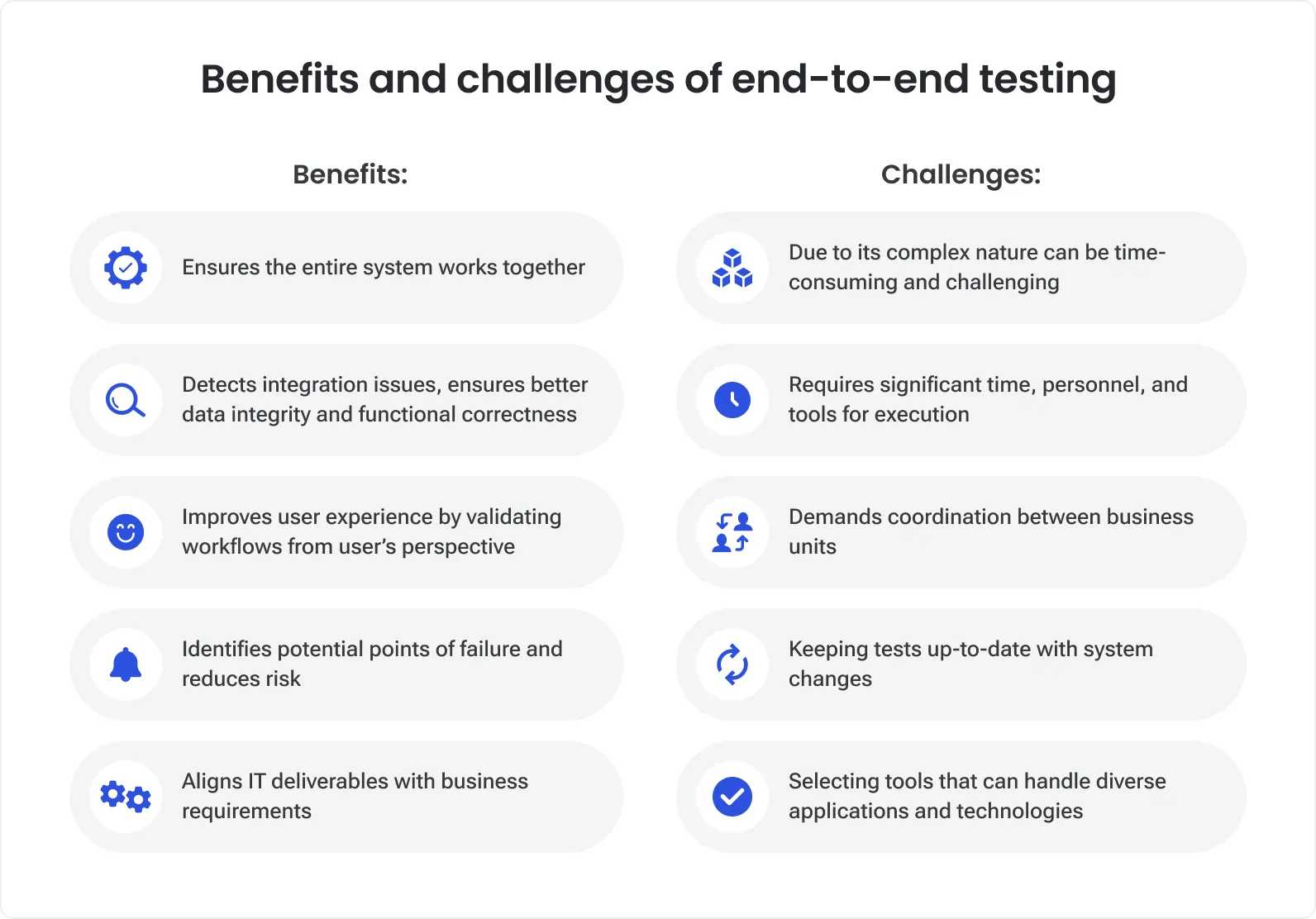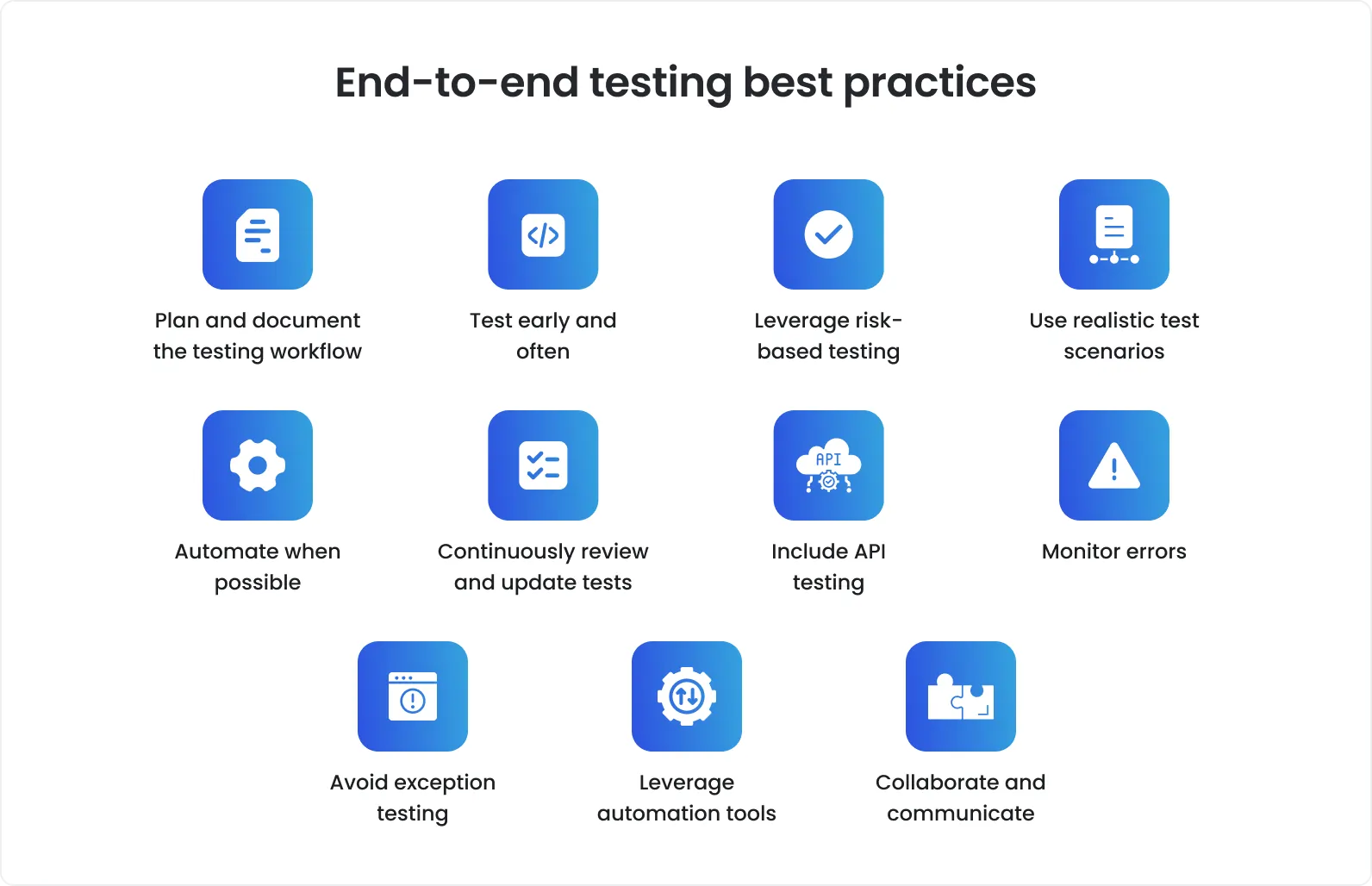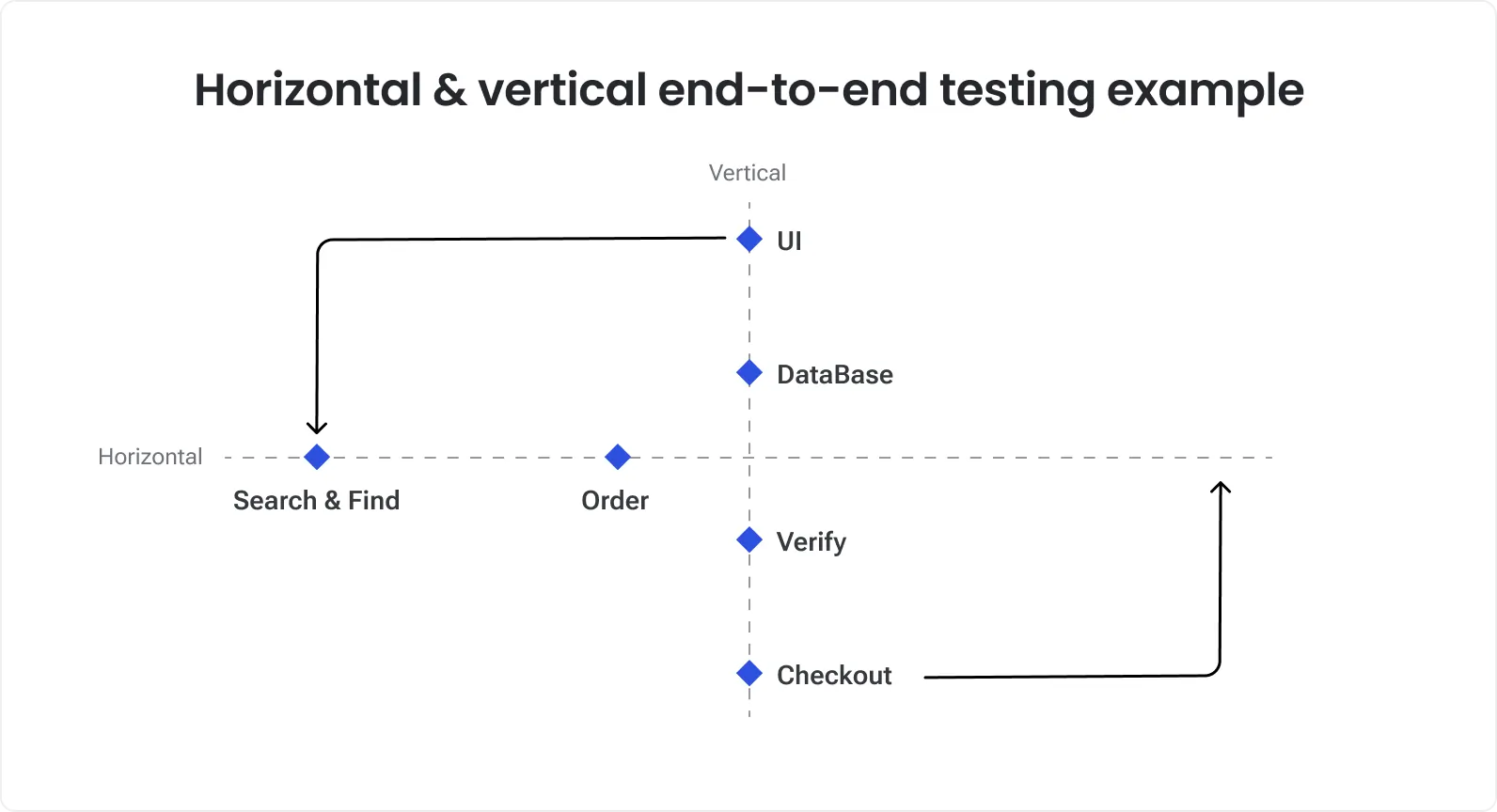Picture this: You intend to launch major updates for a software product with multiple running parts. The process requires your testing team to run various unit tests, code reviews, and integration checks. Unexpectedly, using-facing features fail as soon as the release is live.
Such a scenario is exactly what the risk of overlooking end-to-end testing is all about. One thing is clear: poorly managed end-to-end software testing can realistically derail development timelines. As a result, you get frustrated users and damage the brand's reputation.
In this article, you’ll see how systematic approaches, e2e testing tools, and an intense end-to-end testing process can transform your testing efforts and fortify software quality.
Why does end-to-end testing matter? What is the role of reliability and performance in the game?
In a nutshell, end-to-end testing goes through the user journey. It is like checking the entire thing instead of looking at each particular part separately. The testing team goes through every step, putting themselves into the user’s shoes. End-to-end testing focuses on finding bugs, the ones that smaller tests missed. Besides, the approach reveals issues under real-life conditions. Performance issues surface when tests mimic everyday use. Remember, even one small error in a large system can affect the whole application.

Importance for software reliability and performance
End-to-end testing examines complete user flows. It ensures each layer interacts correctly. In reality, performance bottlenecks hide in the shadows. Unit checks and basic integrations often fail to catch them. In large-scale projects, like QA testing services for e-commerce platforms, every link counts. One should remember that even a single glitch can send shockwaves through the entire app.
The important role of reliability:
When your QA team validates each given subsystem through end-to-end testing, there is a high chance the likelihood of significant defects in a product will go down. You can see an example of how end-to-end testing improves reliability in a real-life setting.
Testing teams launch different, even the most complex features, with a degree of assurance. After e2e tests were passed, they knew simulated realistic user actions and could proceed based on this solid evidence.
The overall perspective on performance:
E2E scenarios often test load and stress conditions that can be handled with the right talent. These reveal inefficiencies in code or architecture and help deal with them early on.
Promoting data exchange between components during use improves response times and system stability.
Explore What is e2e testing? A complete guide for a more foundational look into how e2e fits within broader testing strategies. The piece essentially clarifies the differences between end-to-end checks and other testing methodologies.
Some key benefits for teams, project managers, and testers
End-to-end testing brings benefits going beyond the scope of testing teams. The approach has far-reaching advantages that can reverberate across the entire hierarchy within a company or a business.
What insights end-to-end testing can bring to stakeholders:
C-level executives. Get a better return on software investments. Key processes, like payment flows and data pipelines, are well protected.
Project managers. Experience fewer launch surprises. With the end-to-end testing process integrated into sprints, last-minute failures that derail timelines can be minimized.
QA engineers. Understand how all modules work together. This helps improve test coverage for better results.
If you want more insight into where e2e stands among other tests, check out 5 differences between integration testing and end-to-end testing.
5 most common challenges in end-to-end testing you cannot omit
It would be reasonable to say that we’ve seen some notable benefits end-to-end testing brings. However, as with any method out there, common challenges are in the picture. Below, let’s take a look at some obstacles or bottlenecks end-to-end testing can come along with.
Challenge #1. Complex test environments can bring down even the most resilient infrastructures
Large applications often consist of
multiple microservices;
databases;
external APIs.
Recreating such a complex setting in a test environment can be daunting and tricky. It is especially true if each component includes its unique configurations. Minor mismatches between development, staging, and production environments can yield inconsistent test results and hamper debugging efforts.
Strategies to overcome environment-related challenges
Containerization. Docker or similar tools can package dependencies consistently. Your test environment matches production more closely.
Cloud-based testing. Services like AWS, Azure, or GCP let you spin up short-lived environments for e2e. Cloud-based testing is the way to go if you need to test across multiple operating systems or device types.
Infrastructure-as-a-Code (IaaC). Tools like Terraform or AWS CloudFormation define and replicate infrastructure quickly. You ensure that the environment setup is consistent across different teams.
Pro tip from DeviQA: Use containerization (like Docker) to copy tricky production setups fast, keeping your test environment rock-solid and matched.
In the end, containerization, cloud-based testing, and infrastructure-as-code deal with complex test environments with multiple configurations. These simplify environment configuration and reduce the risk of misalignment. When your environment mirrors reality, your e2e checks produce more reliable outcomes.
Challenge #2. Managing dependencies and integrations can be really tricky
It rarely happens that modern software operates in isolation. In most cases, apps integrate with messaging services, payment gateways, analytics tools, and many more. Each dependency adds a potential point of failure to the equation, especially if it is mismanaged. This is particularly true for APIs requiring thorough functional testing services to ensure seamless integration and reliability.
Tools and practices for smooth integrations
Service virtualization. Simulates external services or APIs. Ideal when third-party resources aren’t always available or cost extra to query.
Mock APIs. Provide controlled responses, letting you test how your system behaves under varied conditions.
Robust integration testing. Write tests validating how two or more services communicate.
Pro tip from DeviQA: Lean on service virtualization to fake third-party APIs, making tests smooth and budget-friendly.
You can isolate external complexities by combining service virtualization, mock APIs, and well-structured integration testing services. This layered approach is a hallmark of end-to-end testing best practices: you only proceed to full-blown e2e once each subsystem is stable in isolation.
Challenge #3. End-to-end tests flakiness and unreliable results
Flaky tests pass sometimes and fail other times, often leading to confusion and wasted effort. Causes range from unstable network connections, and delayed UI rendering, to asynchronous back-end operations.
Best practices to mitigate flaky tests
Proper synchronization. Ensure your tests wait for elements to load or for data processes to complete. Blindly relying on fixed sleep timers can introduce more instability.
Retry mechanisms. Some frameworks allow automatic retries for specific failure types, reducing false negatives. Overall, QA test automation is really important in testing, and here you can see why.
Reliable test data. Inconsistent or corrupted test data can lead to random test failures.
Pro tip from DeviQA: Add smart synchronization with dynamic waits (not sleep timers) to stop flaky fails from async hiccups.
Use robust synchronization strategies, apply end-to-end testing tools that support advanced waiting or retry features, and be meticulous about test data setup. A stable test suite saves time and builds trust in your testing pipeline.
Challenge #4. Long test execution times eat up resources really fast
Comprehensive e2e scenarios often translate into lengthy runs. In agile contexts, slow feedback loops can bottleneck continuous integration and deployment schedules.
Optimizing test execution times
Parallel testing. Split your test suite across multiple machines or containers, running different scenarios simultaneously.
Selective execution. Trigger only relevant e2e scenarios for specific code changes (e.g., skip tests for unaffected modules).
CI/CD integration. Tools like Jenkins, GitLab CI, or GitHub Actions can automatically manage distributed runs, generating real-time feedback.
Pro tip from DeviQA: Split tests for parallel runs on multiple machines, cutting wait times and speeding up CI/CD feedback.
Shorten execution cycles with parallel testing, selective execution, and better CI/CD integration. Faster runs help developers iterate quickly. This boosts productivity and reduces the chance of new bugs.
Challenge #5. Hardships with proper test data management
End-to-end testing often demands large or realistic data sets. Pulling random info from production can raise privacy concerns. Also, data drifting or polluting test environments can lead to inconsistent results.
Ensuring reliable test data usage
Synthetic data generation. Create relevant test data that mimics real-world patterns but excludes sensitive user info.
Data masking. If you must use production snapshots, anonymize personally identifiable information (PII).
Database snapshots. Refresh your test environment regularly with consistent seeds, ensuring each run starts from a known baseline.
Implement a combination of
synthetic data generation;
data masking;
routine database snapshots.
Pro tip from DeviQA: Ensure reliable test data by generating synthetic data, masking sensitive information, and refreshing environments with regular database snapshots.
Overall, these practices keep your tests accurate without compromising compliance or privacy. Remember that taking the most of end-to-end testing stands on several key pillars. One is definitely about addressing any of the common challenges above that might happen to you in the process.
Overcoming end-to-end testing challenges. Best practices and approaches
Clear strategies help tackle testing challenges. Use effective methods to address each given issue. Here are some of the approaches we present to help you deal with any challenges out there.

Approaches for tackling each challenge effectively
In most cases, you might need one or several of these solutions to deal with common end-to-end testing challenges.
#1. Layered testing strategy
Address smaller issues at the unit and integration levels, leaving e2e for broader validation. Consider reading When to use end-to-end testing? to differentiate which scenarios need top-level coverage.
#2. Adopt quality gateways
Only promote code to e2e environments if it passes unit and integration gates. This approach prevents half-baked code from cluttering system-wide checks.
#3. Test orchestration
Tools like Selenium Grid, Cypress Dashboard, and Kubernetes test runners run tests simultaneously. These also manage environments easily.
#4. Monitoring and alerting
Integrate logs and metrics into your end-to-end testing process. Tracking performance metrics can pinpoint slow queries or memory leaks that hamper overall system reliability.
Horizontal vs. Vertical testing. Which is right for your project?
When it comes to software testing, choosing between horizontal and vertical testing can significantly impact your project's success. Horizontal testing ensures that entire user flows work seamlessly across the system, while vertical testing delves into the depths of specific components.
Understanding the differences and knowing when to apply each approach – or a combination of both – can help you achieve a robust and reliable product.

Differences between horizontal and vertical testing
Horizontal testing
Involves validating entire user flows across various modules, akin to scanning from one end of the system to the other. This is end-to-end software testing, ensuring each subsystem communicates effectively in a single flow.
Vertical testing
Focuses on depth, typically drilling into a specific microservice or stack layer (e.g., from QA testing for UI to its data model). This approach is helpful when you suspect issues deeply rooted in a single architectural slice.
How to choose the right approach
Essentially, to choose the approach that fits your needs the best, follow these steps:
Check system complexity. If you have multiple, intricate dependencies, horizontal e2e coverage might be essential to validate the big picture.
Evaluate component volatility. Vertical tests can isolate and confirm changes quickly, without running a full e2e cycle if a microservice undergoes heavy refactoring.
Set the project stage. Early in development, vertical checks can stabilize features. Later, as integration complexities grow, horizontal e2e ensures cohesive functionality.
Pro tip: Most mature testing strategies balance both. Teams perform vertical tests to refine subsystem stability, then adopt horizontal e2e passes to confirm the entire product works as intended.
End-to-end testing tools and frameworks
Selecting the right tools and frameworks for end-to-end testing is critical for ensuring your software functions seamlessly across the user journey.
With various open-source or enterprise options available, each offering unique strengths and trade-offs, evaluating them based on your project's specific needs is essential.
For example, Cypress automation testing services are popular for front-end validations and easy parallelization, meanwhile QA testing services with Playwright offer broad browser coverage and robust asynchronous handling.
Quick check-list of popular E2E testing tools
Now, let’s skim through the tools and frameworks that can help you take the biggest benefits from end-to-end testing:
Selenium
Pros: Widely supported, cross-platform, open-source.
Cons: Setup can be intricate; test flakiness if not carefully managed.
Best for: Teams needing broad language and browser support.
Cypress
Pros: Excellent debugging, real-time reloading, streamlined JS-based testing.
Cons: Primarily front-end oriented; less direct for multi-service back-end validations.
Best for: Modern single-page applications, front-end heavy projects.
Playwright
Pros: Powerful concurrency, out-of-the-box browser coverage (Chromium, Firefox, WebKit).
Cons: It is a relatively newer, smaller ecosystem than Selenium.
Best for: Playwright automation testing services are great for teams wanting stable cross-browser checks and advanced asynchronous capabilities.
TestCafe, Puppeteer, and Others
Pros: Specific niches or specialized features (headless modes, etc.).
Cons: Smaller user base or narrower community support.
Best for: Projects with specialized needs or constraints.
For readers interested in building robust test suites from scratch, see How to build E2E test cases. These guidelines help you match your framework to proven patterns. They also support maintainable code structures.
Criteria for selecting the right tool
When choosing an E2E testing tool, consider the following:
Team expertise. Align with languages your developers and testing engineers already know.
Ecosystem compatibility. Verify the tool integrates well with your CI/CD, reporting dashboards, or cloud providers.
Scalability and support. Check the user community’s size and how frequently new releases or bug fixes appear.
The choice of an E2E testing tool can significantly impact the efficiency and effectiveness of your testing strategy. Consider factors such as team expertise, ecosystem compatibility, and scalability.
Select a tool that meets your current needs and supports your project's growth. Remember, the right tool aligns with your technical requirements and enhances your team's ability to deliver high-quality software.
Conclusion
Building top-notch software is like constructing a bridge. Every piece must hold. End-to-end testing is key for making the bridge hold. It validates multi-step workflows in regulated industries. E2E testing finds issues that more straightforward tests might miss. However, challenges can occur. These include
managing complex environments;
fixing flaky scripts;
optimizing test data;
long run times.
You can improve your project by applying the solutions from each challenge area. Use infrastructure-as-code, parallel execution, service virtualization, and synthetic data generation.
These methods help reduce risks, speed up feedback, and ensure your project is ready for production.
A balanced approach between horizontal and vertical testing also sharpens your strategy.
Finally, choosing the right end-to-end testing tools builds a strong foundation for an efficient testing pipeline.
By addressing testing challenges in software, you create better, high-quality software that satisfies users and meets business objectives. For comprehensive support in this critical area, DeviQA offers expert software testing services you can rely on.
Contact DeviQA and take your software to the next level!
